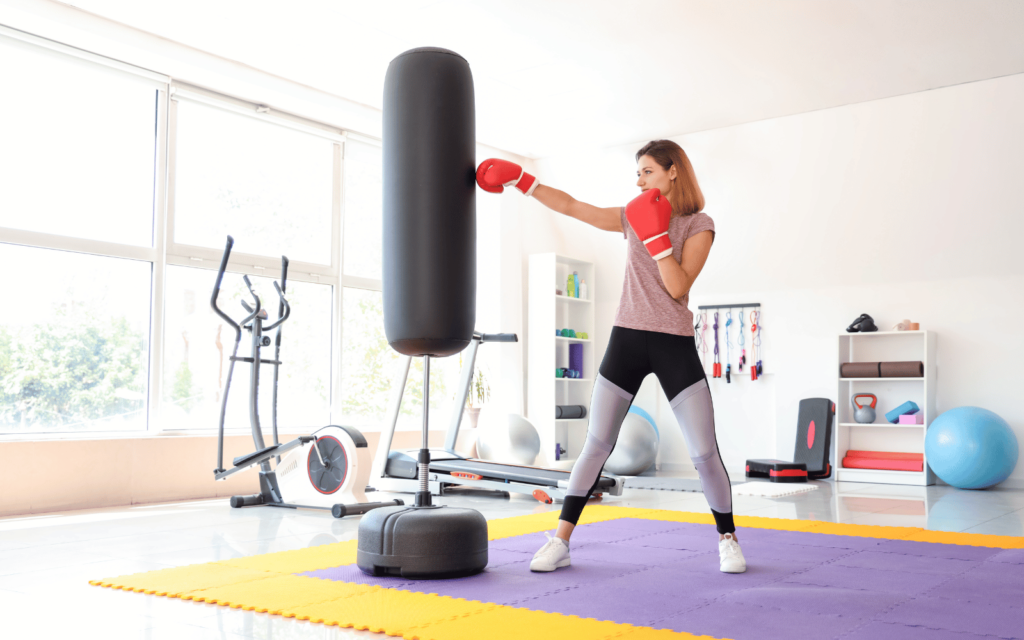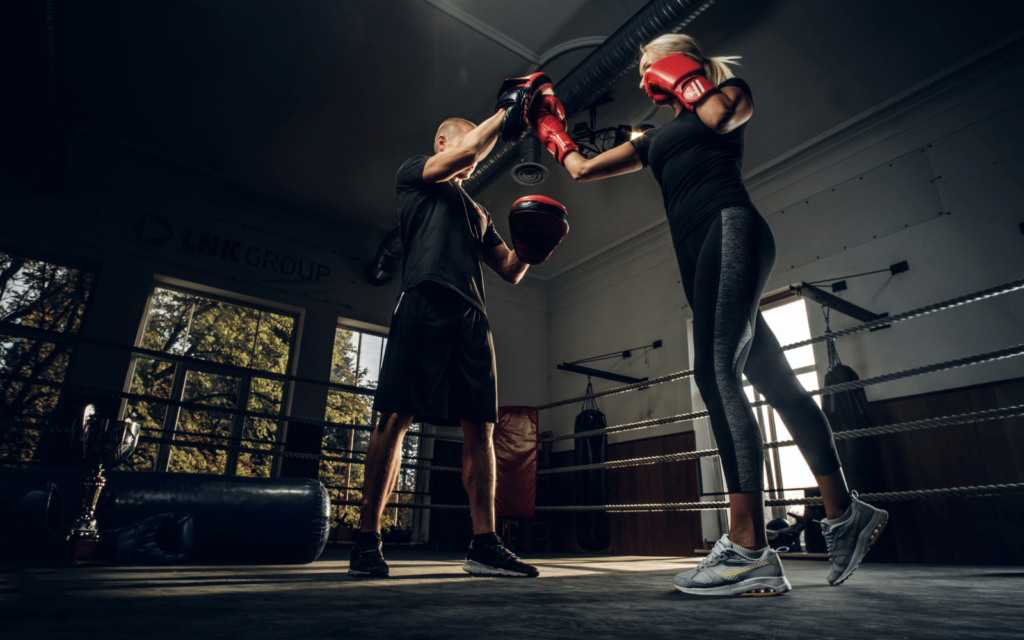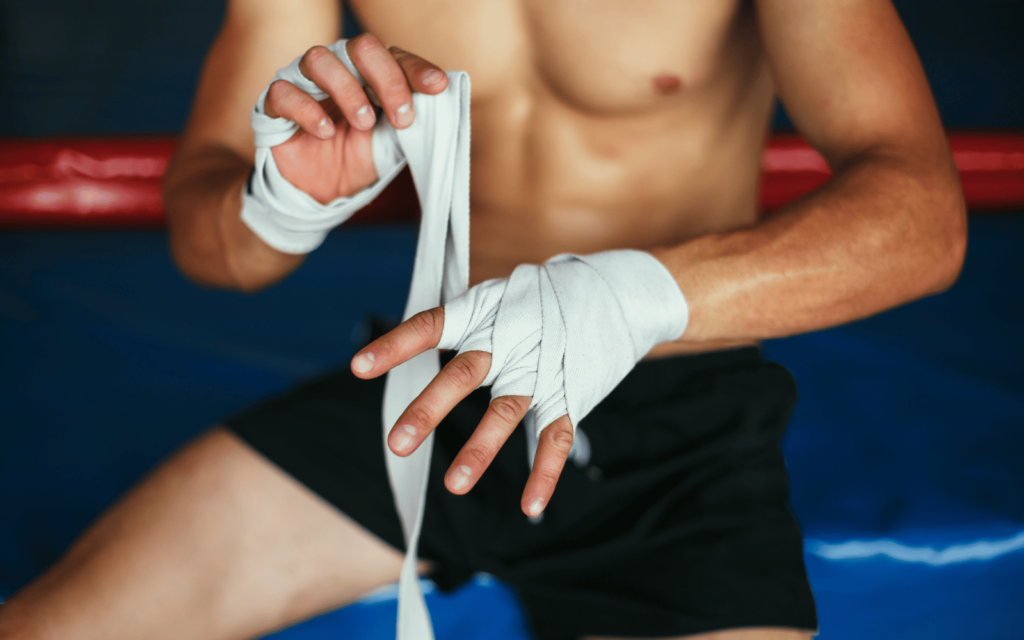Is boxing good for self-defense?
It certainly can be, and in this breakdown, we’re gonna be looking at the key pros and cons of boxing training as it relates to street fights.
You’ll see why it can help both physically and mentally. But also how, in the age of MMA, it has significant limitations, particularly against people with grappling training.
So let’s dive into both sides in more detail!
What Are the Advantages (Pros) of Boxing For Self Defense?
There are some obvious advantages that boxing can have for general self-defense.
And some be surprising – going beyond boxing skills and more into the psychological elements of boxing and experience training.
1. Defensive Reflexes
Boxing is called the sweet science because it’s intended to teach you how to hit and not get hit through body and head movement and other important reflexes.
Every single punch coming your way conditions you to move, slip, and duck in real-time.
And it’s this balance of attack and protection that conditions your reflexes.
When a boxer is weaving and dodging, they’re crafting instincts that could make all the difference in a street situation.
This is especially true against an untrained opponent not used to hitting something – let alone a moving target.
And you don’t even need to join a boxing gym and get hit in the face to start developing this skill. This is what reflex bags are designed to help with.
Also, trying out different boxing styles and stances to see which is best for your body type can help you protect yourself.
For instance, with the proper experience and skill, the Philly Shell can be ultra-effective.
2. Boxing Footwork
The fluid footwork trained in boxing translates perfectly to street fighting as it helps you avoid and maneuver away from attacks.
Proper footwork teaches you:
- Distance control,
- How to set up your punches,
- Create angles,
- Cut off your opponent,
- And evade strikes.
And constantly moving your feet under pressure in training ingrains excellent mobility and agility. Like with defensive head movement, you learn to react instinctively and move your body to respond to an opponent’s movements quickly.
With this footwork, you can improve your positioning and angle off to avoid being cornered or allowing someone to grab hold of you.
Plus, effective footwork establishes solid stances and the ability to drive off your rear leg.
This may help translate into powerful self-defense techniques like forward drives or escapes from grabs via proper distance management.
But this isn’t as natural as you may think.
I know from my experience when starting boxing training in my teens that I would rarely bend my knees or use proper footwork. And so when I’d start putting my full body into punches, I’d usually feel off-balance and leave a lot of openings.
This took nearly 6 months to overcome…
So to speed up your process – here is boxing expert Tony Jeffries sharing some advanced boxing footwork drills!
3. Accurate Punches
The repetitive practice of different punches – the jab, cross, hooks, and uppercuts – makes them more instinctual and sharp.
You may have heard the term muscle memory before.
You can learn to throw punches quickly and hit specific targets even under duress when your brain is overloaded with data and most lose control.
This punching accuracy is a major advantage of self-defence boxing. You can better strike vulnerable areas like the chin, temple, or solar plexus.
Accuracy allows you to create openings by distracting or obscuring the assailant’s vision with targeted punches.
Precise hits also conserve energy compared to swinging wildly, which will drain your energy and leave you open to counters.
And you can adequately drill punches on mitts, bags, and pads to help build techniques in boxing as well as timing, and precision.
4. Punching Power
Developing powerful punches for boxing is an obvious, major benefit of boxing training for self-defense.
Boxing teaches you how to generate maximum force by rotating the body and driving off the rear leg.
This rotational power uses your core muscles and transfers weight into punches.

Without proper training, no matter the type of punch you try, like, say, a hook punch will be mostly all arm and thus lack any real power.
Meanwhile, the kinetic linking that you learn in boxing training, optimizes punching efficiency. Your movement in boxing flows from legs to hips to shoulders, and the whole body works in sync to deliver force.
Through repetitive practice, like footwork, boxing ingrains proper punching technique, becoming instinctual muscle memory.
Combined with the accuracy mentioned above, you learn to strike vital targets like the chin, temples, or even solar plexus for greater damage.
The proper footwork and balance mentioned above also provide you with the stability necessary to unload more powerful punches.
But this is all extremely important parts of the conditioning phase.
5. Conditioning
Boxing is a powerhouse when it comes to cardio.
The intense combination of sparring, pad work, and drills in training not only gets your heart rate up but builds incredible endurance.
It also puts you under pressure in potentially dangerous situations (but hopefully, within a controlled environment), teaching you to remain calm and focused while under duress.
And as we’ll discuss again below, this mental conditioning is invaluable in self-defense scenarios, where keeping a cool head can be as important as physical strength.
6. Confidence & Comfort Under Pressure
Boxing training can be an excellent confidence booster.
If you’ve ever been in a real fight, you’ll know that most people are uncoordinated and unskilled.
Fighting in the real world is very uncommon, so most haven’t needed to train for a single day. Most people have gone their entire lives without punching another.
One study in the US showed that the number of fights high school students got in steadily decreased over a 10-year period.
I mention this to highlight that IF you DO train in any real martial art, you’ll have a big advantage in a bad situation.
Each session is a step towards mastering control over your body and reactions, giving you a real sense of empowerment.

And this, of course, can help in a self-defense scenario.
When you believe in your ability to handle a situation, you project a certain aura of self-confidence that can create doubt in your opponent.
Knowing you’ve trained for such moments and understanding your strength and capabilities can make all the difference in how effectively you respond to a threat.
For instance, an experienced boxer or fighter in general won’t need to prove anything and will be more willing to walk away from a confrontation with their ego intact.
Thus, boxing doesn’t just equip you with physical skills; it fosters the mental and emotional fortitude essential in any self-defense situation.
7. Many Gyms
Boxing has a long history and tradition in Western countries.
And since it’s always been at least in the peripheral of the culture, it’s historically been more widely accepted and accessible for you to train.
This is because most cities have multiple boxing gyms available.
This competition keeps costs lower than other martial arts – typically $100-300 per month.
And with this wealth of options, many boxing gyms are established with experienced trainers passing on proven techniques.
8. Greater Understanding of Consequences
The average person untrained in a martial art is typically more likely to get into a street fight.
That is often because they lack an understanding of the real-world consequences of fighting.
One boxing lesson can usually help give you at least some understanding that without consistent practice – you’re not gonna move like Willie Pep.
And as a boxer, you quickly learn the power of a well-placed punch, both in delivering and receiving. This understanding breeds a deep respect for what physical confrontations can entail.
You become more aware of the potential harm that fighting can cause, making you more likely to avoid unnecessary confrontations.
What are the Limitations (Cons) of Boxing for Self Defense?
Let’s not forget how unpredictable self-defense scenarios are.
A street fight isn’t an organized fight against the late Kimbo Slice. It’s usually an animalistic fit of rage that’s over within seconds with someone legitimately hurt.
So, to help you avoid getting hurt, let’s cover the limitations of boxing for self-defense.
1. Lacks a Grappling Component
The clinch in boxing isn’t so much a grappling move; it is a means to break the rhythm and tire out an opponent by leaning on them (as Tyson Fury does so well). On the street, it could help with dirty boxing.
But other martial arts styles like Brazilian Jiu-Jitsu, Judo, or wrestling have takedowns, submission holds, and techniques to defend against these attacks.
2. No Takedown Defense
Since boxing, like other stand-up
In a self-defense situation where an attacker knows how to grapple, the boxer’s unfamiliarity with fighting on the ground or defending against takedowns and submission holds can cancel out any boxing training.
These grappling martial arts provide techniques to control or neutralize an opponent without necessarily striking them – restraining them and leaving them helpless.
And in confrontations with multiple opponents, there’s a higher chance of ending up on the ground.
3. No Kicking Component
Despite Western boxing once being the most widely known striking sport, the rise of MMA has brought a wide range of striking to the forefront.
For instance, Muay Thai and kickboxing are growing in popularity. And while boxing has two weapons, Muay Thai has 8, Lethwei has 9 (head strikes), and something like Krav Maga has all that and more.
And let’s say you come up against a Muay Thai fighter with strong leg kicks. Not only will you be unable to handle the pain of a leg kick, but you won’t have conditioned your shins to deliver powerful kicks yourself.
4. Conditioned To Use Boxing Gloves
Boxing gloves and hand wraps are a fundamental component of its training.

And those used for training are usually around 16oz – offering a ton of padding and protection. And while this is helpful in training, you will not be able to glove up before a street altercation.
That means that every punch you throw can potentially break your hand.
Without gloves, you won’t be able to throw with the same intensity or willy-nillyness as you do With gloves. And so you’ll need to adapt on the fly, which adds another layer of complexity to the situation.
5. Trained To Fight One Opponent At a Time
Boxing, at its core, is designed for one-on-one combat.
It teaches you to face a single opponent, gauging their body movements and responding accordingly. While effective in a ring, this singular focus can be a limitation in real-life situations where you might confront multiple attackers.
Boxing doesn’t typically train you for the awareness and strategies to handle multiple threats simultaneously.
And in real life, fighting several attackers, you may need a 360-degree awareness.
But it’s towards the bottom of the list because no martial art can teach you to have eyes on the back of your head. And having the boxing skills to neutralize one opponent can usually translate into effectiveness against multiple.
Such as when professional boxer Nikolai Vlasenko KO’ed 2 fellow Russians back to back (viewer discretion is advised).
Best Boxing Combination for Self-Defense
In a self-defense context, the best boxing combinations are those that are simple, effective, and quick to execute.
The goal is to neutralize the threat and create an opportunity to escape. Here are some practical combinations:
Jab-Cross (1, 2)
These basic punches are the bread and butter of boxing combinations. A quick jab (a straight punch with the lead hand) and a cross (a straight punch with the rear hand) can be very effective.
The jab is used to gauge distance and create an opening, while the cross delivers more power, aiming to stop the attacker or create distance to escape.
Jab-Cross-Hook (1, 2, 3/4)
After the initial jab-cross, adding a hook (a semi-circular punch aimed at the side of the opponent’s head or body shot) can be very effective.
The hook is a powerful punch and can be a fight-ender if it connects properly, especially when targeting the jaw or a body hook to the liver.
Double Jab-Cross (1, 1, 2)
This combination starts with two quick jabs to disorient or blind the attacker, followed by a powerful cross.
The double jab helps maintain distance, while the cross is a strong deterrent against closing that distance.
Cross-Hook-Cross (2, 3/4, 2)
Starting with a cross can catch an assailant off guard, especially if they are expecting a jab first. Following the initial cross with a hook and then another cross creates a powerful, varied attack that can be difficult to defend against.
Jab-Rear UpperCut (1, 6)
A jab to start, followed by an uppercut (a vertical, upward strike aimed under the opponent’s chin) can be devastating, particularly in close quarters.
Jab-Cross-Body Hook (1, 2, 7)
This combination starts conventionally with a jab and a cross but then shifts to a body hook. Targeting the body, especially the ribs or liver, with a hook can be extremely effective in incapacitating an attacker.
But again – when thinking about these combos – remember that someone out there is grappling right now. And they may be able to catch a lazy jab or poorly thrown hook and drag you to the ground.
So remember – the goal is to create an opportunity to escape, not to engage in a prolonged fight.
Speed, efficiency, and the element of surprise are critical.
Also, always be aware of your surroundings and look for the best way to remove yourself from the threat as safely as possible.
Best Martial Art to Combine With Boxing
So as you can despite some limitations there are lots of benefits of boxing.
And armed with even boxing basics combined with other martial arts styles like BJJ or Wrestling, you can handle yourself against most.
Brazilian Jiu-Jitsu (BJJ)
BJJ focuses on ground fighting and submission grappling. It’s an excellent complement to boxing as it provides the skills necessary to defend oneself if a fight goes to the ground — a scenario where boxers, who are trained primarily in stand-up fighting, might be vulnerable. BJJ teaches how to control an opponent on the ground, escape from disadvantageous positions, and apply joint locks or chokeholds.
Judo
Similar to BJJ in its focus on grappling, Judo specializes in throws and takedowns, along with some ground fighting techniques. It’s an effective martial art to combine with boxing because it offers a way to neutralize an opponent by taking them to the ground, which can be especially useful against someone trying to close the distance, a common strategy against boxers.
Muay Thai
Known as the “Art of Eight Limbs,” Muay Thai incorporates fists, elbows, knees, and shins. Muay Thai’s clinching techniques and use of elbows and knees can be beneficial in close-quarter situations where boxing punches might be less effective. Its emphasis on kicks also helps boxers cover the range where they might otherwise be vulnerable.
Krav Maga
Krav Maga is designed specifically for real-world self-defense and combines techniques from various martial arts. It emphasizes practical techniques, aggression, and situational awareness. Combining Krav Maga with boxing can enhance a practitioner’s ability to respond effectively in unpredictable self-defense situations.
Wrestling
Wrestling, particularly freestyle or Greco-Roman, is beneficial for learning how to control an opponent, maintain balance, and execute takedowns. These skills complement the striking focus of boxing, providing a more well-rounded approach to self-defense, especially in handling opponents who might try to force you into a clinch or take you down.
Closing Up Boxing for Self-Defense
So there you have it.
While boxing does equip you with solid striking fundamentals, important reflexes, and a certain sense of confidence, it’s not a one-size-fits-all solution for self-defense.
Its focus on only hands with grappling and kicking techniques can leave gaps in a real-world defense strategy.
However, when complemented with other martial arts, boxing can play a key component in a robust self-defense repertoire.
